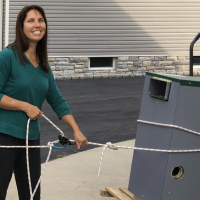Best Of
Re: Recommendation for 90,000 BTU (net) hot water boiler?
I agree with the Steam Whisperer about getting the valves set just right the removing the handles. I allso tighten the packing nut so the valves cant vibrate to a different position. To be a real nice guy, hang the handles near the valves with a note. DO NOT ADJUST THESE VALVES.
I also agree with doing an easy Whole House Load Calc for your Mom. You should learn how to do them fast and easy. Mom's house is good practice @delcrossv. And it's not like you have not heard this before in your time here on HeatingHelp.com. You might find the EG 30 or the EG 35 will work just fine and save you on the boiler cost and the operating cost. WIN WIN!
Re: Recommendation for 90,000 BTU (net) hot water boiler?
You may have seen this before but is work repeating….My previous home was 3200 sq ft on 2 floors, wood frame, with 700 sq ft of glass area. 2800 sq ft was the original 1906 home with about 600 sq ft of original windows with storms. The heatloss was about 45,000 btu/hr. This was confirmed with several seasons of checking gas usage during sub zero temps… 100,000 btu/hr input condensing boiler was running about 50% of the time.
Unless your Mom lives in a mansion, I'd check the heat loss. If it is a high mass system, just pipe it primary/secondary with a supply to return bypass on the boiler loop. Often times all of the boiler loop piping can be 3/4 inch copper in modest homes and maybe 1 inch in larger homes. Makes it really easy to pipe it in. The main loop still needs to be size to the flow rate of the system usually 1 inch in modest homes and 1 1/4 inch in larger homes.
My experience has been: when going from a standard atmospheric CI boiler double the size needed to a properly sized atmospheric cast iron unit of the same rated efficiency, typically the fuel usage drops about 12%.
When it comes to residential cast iron boilers, there doesn't seem to be any particular standouts. Most are lower water content, which works really well if piped as above, since the boiler tends to heat soak on each cycle, drying out the casting if needed during the shoulder seasons. The Weil CG's ( which in my experience is thier longest lived boiler) have really low water content, so they tend to perculate if there's alot of dirt in the system. A Burnham or Dunkirk have a little bit more water.
Definitely don't use a standard efficiency copper tube…they simply cannot handle any low return temps without a lot of damage due to condensation in the heat exchanger.
Re: Polaris PBCG gas valve replacement
After a couple more failed visits from professional companies, and repairing a few bad spade connections and replacing a couple of electronic boards, I finally bit the bullet and did the gas valve replacement myself. I had to use a weird gas piping routing, but it works normally and seems to be set correctly. I think it may be built so that the negative pressure from the blower intake regulates the valve outlet volume/pressure, making it agnostic as to propane or natural gas.
Thanks for the advice from various people here, you were more helpful than most of the pros who actually looked at the heater.
Re: Backdrafting Gas Water Heater + Boiler Noise Issue Advice?
If you gently "thump" the side of the valve with a rubber handled screw driver the pitch may change.
The same screwdriver can also be used as stethoscope by putting the tip against the valve and the handle pressed to your ear. You could listen to the inducer motor also.
Re: Tekmar 680 snowmelt control - control what?
Personally I would let the boiler run its own pump.
Re: Lochinvar Noble NKC199 Heat Exchanger flush
Not if it's got the proper chemistry and there is no oxygen intrusion
Re: Smart 40 indirect coupler leaking T&P relief
Two things to address.
- That is a black iron fitting on the open system part of the tank. That coupling should be stainless steel or brass.
- That should work just like a regular water heater tank. Turn off the cold and let the pressure off by draining the tank. once there is no pressure on the tank. you can remove the T&P valve to replace the coupling and tighten the fitting.
Re: Smart 40 indirect coupler leaking T&P relief
Yes, you can. After shutting off the water to the water heater, trip the relief valve until no water comes out then do what @EdTheHeaterMan says above. And while you're at it, replace the relief valve too.
 Intplm.
Intplm.
Re: How can I find (and test) my steam system main vent?
First tee is closest to the boiler steam supply — it's the radiator supply that is reached first by the steam. Last is at the other side of the main (the end of it). It is reached last by the steam.
The main drops to the floor via a vertical pipe at some point to let the water return to the boiler, which presumably is near the floor. The picture you posted isn't really applicable.
From :17 to :21 in your second video you are looking from bottom to top of the vertical "drop" that marks the end of one of your mains.
Your video isn't that helpful, it's probably not your fault because so much is behind walls and ceilings. But the majority of your video seems to be aimed at sewage and water lines.
You might have a vent on this little riser, seen at :24 in your second video:
Here at :28 I believe is your last riser to a radiator, at least on this main. I can't tell if you have more than one main.




